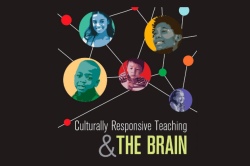
Listen to my interview with Dena Simmons (or read the transcript):
The difference between teachers and their students has never been so stark. A recent report from the National Center for Education Statistics shows that since 2014, white students no longer make up the majority in American schools. Future projections show the white population shrinking to a smaller and smaller proportion of the whole, and the combined populations of of students from other ethnic groups increasing so that together, they make up a steadily growing majority.
By contrast, teachers in the U.S. are overwhelmingly white.
What this tells me is that the life experiences of most of the people in charge of our classrooms have been pretty different from the experiences of most of their students.
And that matters.
It matters because our work is not strictly academic. Not by a long shot. In order for our students to perform well academically, they need to feel safe, both physically and psychologically. They need to feel a sense of belonging. They need to feel seen and valued for who they are. For our students of color, finding this safe, accepting place is rare, especially if most of their teachers have a dramatically different background from their own. This problem can be even more pronounced for students of color who attend schools where their peers are also mostly white.
This does not mean that all white teachers are racists or that they are deliberately doing things to hurt their students of color. But what IS happening, far too often, is that teachers are doing things that harm these students’ self-perception without even realizing it.
Dena Simmons, the director of education at the Yale Center for Emotional Intelligence, understands this problem far too well.
In her 2015 TED talk, “How Students of Color Confront Impostor Syndrome,” she tells the story of how, as a young black girl, she left the Bronx neighborhood where she lived with her single mother and two sisters to attend a prestigious boarding school in Connecticut. Although she got an excellent education there and followed that up with a series of impressive academic and professional accomplishments, she always felt out of place, torn between the world she’d grown up in and her identity as an accomplished scholar. “Eternal impostor syndrome,” she calls it.
This struggle was made much harder by many of her teachers, in the things they said to her and the messages they sent, messages that basically told Dena that who she was was not okay.
Later in life Dena returned to the Bronx to teach middle school, and she was determined to create the kind of atmosphere she wished she’d had, one that values each student’s unique identity and history. In her TED talk, she gives us a glimpse of how that worked.
Now, we pick up where that TED talk left off, with some specific advice about what teachers can do to help their students of color not just survive, but thrive in the classroom, with a fully developed, strong sense of pride in who they are, where they came from, and what they’re capable of.
1. Teach Students of Color to Love Themselves
“There’s nothing more revolutionary than teaching our young people in general to love themselves,” Simmons says, “and particularly young people of color, because they don’t have to look too far to see negative images of themselves displayed throughout the media. We can teach our young people to love themselves by centering our instruction on their lives, their realities and their experiences, and using their lives as cultural reference to our instruction.”
Here are some things teachers can do to nurture this self-love and pride in their students:
- Really get to know your students. This is the first step toward helping students love themselves. This should be done in both formal and informal ways: A simple survey can help you gather information quickly, and spending time with students outside of class can help you see them in a different light. In her school, Simmons occasionally attended gym class with her students and invited them to have lunch with her off-campus.
- Create ways for students to bring pieces of their lives into the classroom. By allowing students to share in school the things they value outside of school, we demonstrate that every aspect of who they are is important. One way Simmons did this was to have students create personalized playlists of their favorite (school-appropriate) music that could be played during certain class activities.
- Honor their language. When teachers attempt to “fix” students’ language to make it more standardized, they often communicate to students that their way of speaking is wrong. Instead, we could explain that students need to become bilingual, that using academically standard language will open doors for them in some contexts. This approach honors where students come from and acknowledges the value of their home vernacular. Simmons advises teachers to have an honest conversation with students: “How we speak when we are outside is how we speak. It’s totally fine. Then there’s a way we speak in the classroom, and that just makes us bilingual as opposed to right and wrong. When you say to someone, ‘Cut it out,’ you’re saying, ‘Cut out who you are,’ and we don’t want to do that.”
- Tell them you love them. “When I was in the classroom,” Simmons says, “I actually had posters that would say, ‘Ms. Simmons loves you,’ and it wasn’t uncommon to walk into my classroom and for me and a student to share I love you’s with each other. When we do that, we create a space for our students of color to know that their schooling values their experiences, and it values who they are.”
2. Invite Families and Community Members to Become Partners in Educating Students
“When you partner with communities, when you partner with families,” Simmons explains, “students really internalize that they matter. They internalize that their communities matter, and they also begin to understand that they have a role in developing and engaging in their communities. What I learned when I had to leave the Bronx to go to boarding school was that the Bronx had nothing to offer me. How painful it was to think of the place that raised me, the place that I called home was actually not good. And so I had to spend some time reshifting and reframing how I thought about the Bronx, that the Bronx was something to return to as opposed to something to leave. And I think educators, in the process of seeing their communities and their families as assets, begin to shift from deficit-based mindset to an asset-based mindset.”
- Take inventory. Using a community development approach called asset mapping, build a list of all the various resources you could take advantage of, partnerships you could form with parents and community members to enrich the education of your students.
- Use community resources as curriculum. Find ways to tie local resources to the things you’re teaching in class. You can invite community members in as guest speakers or take students on field trips to local establishments. Doing this gives students a sense of pride in their neighborhood and helps them see home as an abundant place.
- Keep parents involved through multiple channels. Invite parents to attend classroom events, use digital and non-digital means to let parents know what’s going on in class and what they can do to help. If what you’re doing now isn’t working, try something else. Ask families what would work for them until you find an effective approach.
3. Expose Students to Role Models of Color
Growing up, Simmons says most of the role models she saw in the media were white. “So in many ways, I would say implicitly I learned to favor whiteness. I learned to think that everything white was better … I think that is true for many people of color.” By making sure all of our students—not just students of color—are exposed to a variety of diverse role models, we help them broaden their own goals and see what’s possible for everyone.
- Invite guest speakers and mentors of color into the classroom. Find ways to arrange visits or guest presentations people of color who work in all sorts of industries. These guests can come from your local area or, with the help of video conferencing, anywhere else in the world.
- Make sure your classroom or school library has a variety of texts that include positive, diverse characters. The site We Need Diverse Books maintains a growing list of books that meet this need. Canerow is also building a similar list, and their blog expands the definition of “text” to other forms of media like music and film.
- Support efforts to improve teacher diversity. Currently, there is a shortage of teachers of color in the U.S., which further limits our students’ interactions with professional role models of color. This report by the Center for Amercian Progress outlines steps that can be taken by states, districts, school leaders, and universities to attract, train, and retain teachers of color. If you are a classroom teacher and have no direct impact in this area, what you can do is learn more about the problem and support efforts in your own school to improve it.
4. Disrupt the Single Narrative of Students of Color
“I think a lot of times when teachers go back home, and they talk to their friends, the stories they tell about their students only perpetuate the status quo, what it means to be a kid of color,” says Simmons. “These single narratives are perpetuated, and in many ways, I think are problematic because they’re incomplete, they flatten the wholeness of our students.” The concept of the single narrative is illustrated beautifully by Chimamanda Adichie in her TED talk, The Danger of a Single Story, which I strongly recommend you watch to fully understand this idea.
We are all part of this conversation, with many of us only perpetuating the existing narrative about our students of color in the anecdotes we share about them. So how do we disrupt that? How do we work to change that narrative so society at large begins to see our students of color with more complexity, and so the students see themselves differently?
- Empower students to tell their own stories. Look for ways to let students share their own diverse experiences, whether it’s through spoken word, in conversations, or in more finished products like written pieces, podcasts, videos, or other multimedia.
- Pay attention to your own storytelling, your own language. When you are retelling a story of something one of your students did, ask yourself if the story is contributing to a negative narrative, if it perpetuates a stereotype about a particular group of students. And check your language: When you talk about certain groups of students, do you say “these kids,” or “our kids”? A subtle shift in language represents a major change in thinking.
- Challenge others. When your colleagues tell these kinds of single-narrative stories, dig for context. Ask about the strengths of the students being described. Push for the full picture.
Small Changes Make a Difference
None of the actions outlined here are simple, and none of them offer a quick fix. But implementing them consistently, with the belief that this work is important, will make your classroom a place where students of color will flourish.
You can find Dena Simmons on Twitter at @denasimmons. If you enjoyed her TED talk above, check out her other two, It’s 10pm. Do you know where your children are? and What to do if your student comes at you with scissors?
Join my mailing list and get weekly tips, tools, and inspiration—in quick, bite-sized packages—all geared toward making your teaching more effective and fun. You’ll also get access to my members-only library of free downloadable resources, including my e-booklet, 20 Ways to Cut Your Grading Time in Half, which has helped thousands of teachers spend less time grading!





Thank you so much for this post! Great imformation! I appreciate everything you do to help our days go smoothly! Thank you for all your help and hard work!! 🙂
When I read “Teach Students of Color to Love Themselves” I remember the first time I complimented a student on her beautiful skin color–it was a rich mahogany that took my breath away. She grinned and said no one had ever said that to her before and I was amazed at that. From that day forward she always had a smile for me, yet this student wasn’t even in any of my classes. It taught me that we can teach students to be proud of their heritage, and we can also make them proud of what makes them unique in whatever way they are!
I teach elementary instrumental music. As with all children, these affirmations you addressed really matter. Our children of color don’t hear/see them enough, as you posited. One of the most frequent gentle classroom suggestions I give my students is regarding eye contact: It matters, because it conveys self-awareness and respect for the person at whom we are looking to whom we are speaking or listening. I often say, “Look at me,” when I am speaking to a child about classwork or behavior or a new fingering. Thank you so much for this valuable reminder.
This is a fabulous article, and I’d love to share it with our facilitators and coaches of Critical Friends Group work since we try to bring equity to the forefront in our work. Will you format this as a PDF that we can download and share, please?
Hi, Luci! This is Holly Burcham, a CoP Customer Experience Manager. At one point Jenn did have a PDF plug-in, but it just caused too many problems.
We apologize, but the best we can do is have you click on the tiny printer under “What to Read Next.” Another window will open…a printable version of the post. Go into your browser menu to “print” (top right corner on Chrome), but choose the option to save as a PDF where it asks for the printer destination. Hope this helps!
Great article and actionable tips to raise awareness and remedy the challenges that we face in this area. I really loved her transparency in stating how she learned to think that everything white was better. Her transparency helped me to identify this flawed thinking in myself and to take actions to think differently. I also liked that she stated that this type of thinking is pervasive in most people of color. This article helped me immensely. Thank you to the author and Dena Simmons for sharing your views and perspectives.
I teach at an international school in Panama and I found this podcast very helpful to me as I relate to my students. Thanks for this!
Can anyone recommend a book, other than To Kill A Mocking Bird?
I have two Sudanese students in a predominantly white class. The stereotypes in that story bother me and it really bothers me that they are going to have to sit in a class that reads the story aloud and will experience the awkwardness of hearing the “n” word.
I get that “it’s history.” But surely there’s a great non-fiction book out there that would help these young men feel proud instead of embarrassed.
Hi Cari! Thanks for writing in. I’m Holly, Customer Experience Manager, and I adore TKAM. Here are a few things that might help:
First, last May, Jenn had people write in and suggest books to use in the classroom. You can see the list HERE and dig through to find something that works for your situation.
I also found THIS PAGE recently offering TKAM read-alikes. I don’t think any are nonfiction, but maybe there’s something that will work.
As a bit of an aside, HERE is my favorite teaching resource for this novel from Facing History and Ourselves. There’s even a section about how to teach your students to be respectful of the language which–I believe–will come in handy no matter who’s reading it.
Lastly, CommonLit has a set of free supplemental readings to go with the book, too!
I know this is more than you asked for, but I hope it helps!
Thank you for the helpful and relevant suggestions. I am a teacher in a majority white, rural school. As a white, male, Sociology teacher I am always interested in how “school” is perceived by my students of color. What are their experiences and how does this shape behavior and interactions within the majority culture. I have appreciated the honest conversations I’ve had with students in this regard and it had led me to make some changes in how I approach my students. Your advice in this article is good and worthwhile to implement for ANY teacher who had the opportunity to teach in a diverse setting. Thanks.
Jeff, I’m so glad to hear that you found value in this. Thanks for taking the time to write!
This article resonates deeply. As a teacher of color, I recognize the importance of implementing all that is suggested in cultivating relationships with all students and especially my students of color. The movement toward more teacher of color representation in the classroom has never been so important. I remember one of my students sharing that she was nervous because I was her only teacher of color up until that point in her academic experience did not include a teacher of color. All in all, your message is important to share. Thank you for this information.
Cultivating relationships especially with students of color? Please explain?
Very practical help for supporting students that don’t look like me. I can’t walk in their shoes but I can support their journey.
What amazing gems to consider when connecting with students of color!